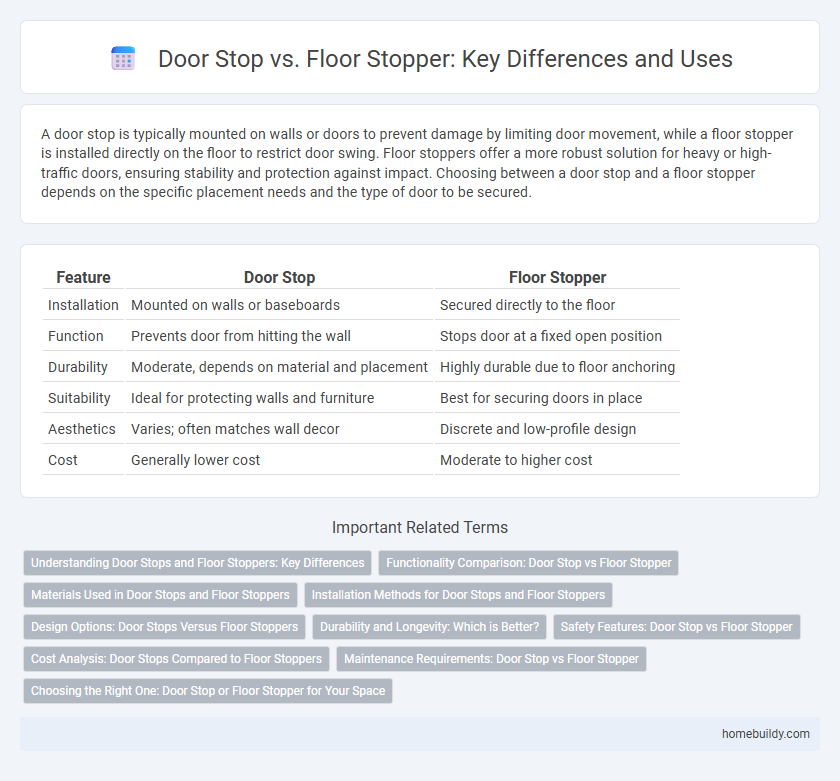A door stop is typically mounted on walls or doors to prevent damage by limiting door movement, while a floor stopper is installed directly on the floor to restrict door swing. Floor stoppers offer a more robust solution for heavy or high-traffic doors, ensuring stability and protection against impact. Choosing between a door stop and a floor stopper depends on the specific placement needs and the type of door to be secured.
Table of Comparison
| Feature | Door Stop | Floor Stopper |
|---|---|---|
| Installation | Mounted on walls or baseboards | Secured directly to the floor |
| Function | Prevents door from hitting the wall | Stops door at a fixed open position |
| Durability | Moderate, depends on material and placement | Highly durable due to floor anchoring |
| Suitability | Ideal for protecting walls and furniture | Best for securing doors in place |
| Aesthetics | Varies; often matches wall decor | Discrete and low-profile design |
| Cost | Generally lower cost | Moderate to higher cost |
Understanding Door Stops and Floor Stoppers: Key Differences
Door stops are typically mounted on walls or doors to prevent damage by limiting door movement, while floor stoppers are anchored to the floor, providing a physical barrier to door swing. Floor stoppers offer increased stability and are ideal for heavier doors or areas requiring stronger impact resistance. Choosing between the two depends on installation preference, door type, and the level of protection needed for walls and floors.
Functionality Comparison: Door Stop vs Floor Stopper
Door stops are designed to prevent doors from swinging too far, offering protection to walls and door hinges through wall-mounted or hinge-mounted mechanisms. Floor stoppers provide a similar function but are installed directly on the floor, allowing for more flexible placement and effective control of door movement at the base level. Both types enhance door safety and durability, yet floor stoppers often provide greater stability and are ideal for heavy doors or high-traffic areas.
Materials Used in Door Stops and Floor Stoppers
Door stops and floor stoppers are commonly made from materials such as rubber, metal, and plastic, each offering different durability and grip levels. Rubber door stops provide excellent floor protection and slip resistance, while metal models, often constructed from stainless steel or brass, offer enhanced strength and longevity. Plastic floor stoppers are lightweight and cost-effective, suitable for light-duty applications but may lack the durability of rubber or metal counterparts.
Installation Methods for Door Stops and Floor Stoppers
Door stops are typically installed on walls or baseboards using screws or adhesive pads, providing a simple barrier to prevent door damage. Floor stoppers require mounting directly onto the floor surface, often involving drilling and securing with anchors for stability against the door's impact. The installation method for door stops is less invasive compared to floor stoppers, which demand precise placement to avoid tripping hazards while effectively halting door movement.
Design Options: Door Stops Versus Floor Stoppers
Door stops offer a variety of design options including wall-mounted, hinge-pin, and magnetic models, providing versatile placement and aesthetic integration with existing decor. Floor stoppers are typically bulkier and designed for heavy-duty use, featuring durable materials like rubber or metal to prevent door movement at floor level. Choosing between door stops and floor stoppers depends on design preference, space constraints, and the level of door protection required.
Durability and Longevity: Which is Better?
Door stops mounted on walls or doors typically offer enhanced durability due to their secure positioning, reducing wear and tear compared to floor stoppers exposed to foot traffic and cleaning activities. Floor stoppers often face impact and abrasion from shoes, furniture movement, and vacuum cleaners, which can shorten their lifespan and require more frequent replacement. Choosing a wall or door-mounted door stop generally ensures greater longevity and sustained performance in high-traffic environments.
Safety Features: Door Stop vs Floor Stopper
Door stops and floor stoppers both enhance safety by preventing doors from damaging walls or causing injuries, but floor stoppers offer greater stability due to their fixed placement on the floor. Door stops are typically mounted on walls or baseboards, providing a cushioning effect that reduces impact force, while floor stoppers physically block door movement, minimizing the risk of sudden swings. Choosing between door stops and floor stoppers depends on specific safety needs, with floor stoppers often preferred in high-traffic or commercial environments for enhanced protection.
Cost Analysis: Door Stops Compared to Floor Stoppers
Door stops generally offer a more cost-effective solution compared to floor stoppers, with prices ranging from $5 to $20 depending on materials such as rubber, metal, or plastic. Floor stoppers typically incur higher installation costs, averaging $15 to $40, due to the need for floor drilling or adhesive application. When factoring in long-term durability and maintenance, standard door stops often provide greater value for budget-conscious consumers seeking simple, effective door protection.
Maintenance Requirements: Door Stop vs Floor Stopper
Door stops typically require minimal maintenance, involving periodic cleaning and occasional tightening of screws to ensure stability. Floor stoppers, exposed to foot traffic and potential impact, often need more frequent inspection for wear and tear, with replacement parts sometimes necessary to maintain effectiveness. Proper maintenance of both devices prolongs their lifespan and prevents damage to doors and walls.
Choosing the Right One: Door Stop or Floor Stopper for Your Space
Selecting between a door stop and a floor stopper depends on your space's layout and usage needs; door stops, often mounted on walls or doors, prevent damage by limiting door swing, while floor stoppers provide a fixed physical barrier positioned on the floor. For high-traffic areas or rooms with limited wall space, floor stoppers offer durable protection against door impact. Consider the door's weight, opening angle, and flooring type to determine the most effective stopper that balances safety and convenience.
door stop vs floor stopper Infographic

 homebuildy.com
homebuildy.com